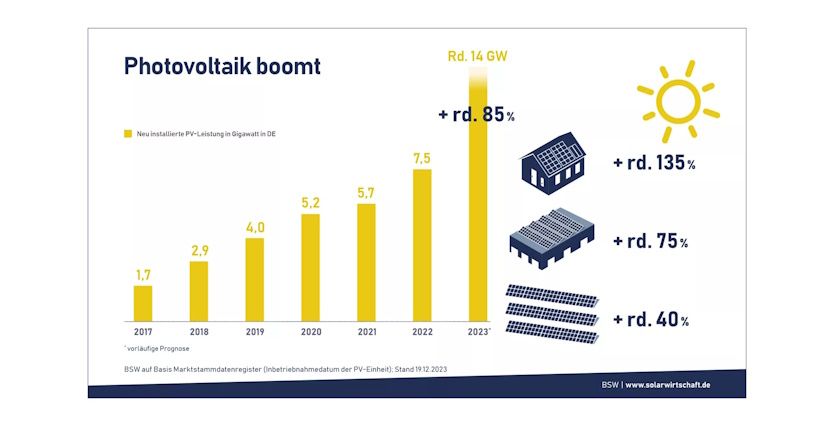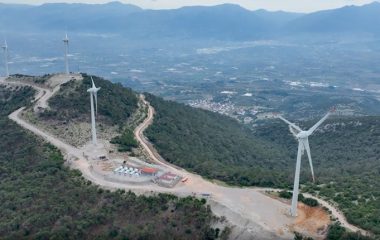
Photo: Hans from Pixabay
Renewable energy capacity in Germany grew by more than 17 GW or 12% in 2023 to a total of around 170 GW. The increase was driven by solar (14.1 GW) and wind power (3.2 GW).
The Federal Network Agency, the national regulatory authority also known as Bundesnetzagentur or BNetzA, said that the growth in solar capacity in 2023 amounted to 14.1 GW, nearly two times more than in 2022 (7.5 GW).
BNetzA attributed it to private solar installations as well as ground-mounted and commercial rooftop solar capacity.
According to the German Solar Industry Association (BSW), more than a million new solar systems to generate electricity or heat were installed in Germany last year, setting a record.
Half of the new solar installations were in the home segment
Half of the new solar installations were in the home segment, where the increase amounted to 135%, BSW said. About 31% (4.3 GW) were ground-mounted solar parks (40% increase), and 18% (2.5 GW) were photovoltaic facilities on company roofs (75% increase).

About 3.7 million PV systems that were in operation at the end of the year in Germany generated 62 TWh in 2023, covering around 12% of Germany’s electricity consumption, BSW added.
At the end of 2023, Germany’s solar power capacity totalled 81.7 GW, meaning 19 GW of new capacity will be needed each year to reach the target of 215 GW in 2030, BNetzA pointed out.
The number of plug-in balcony solar modules is increasing
It added that about 70% of solar installations on buildings have battery storage systems.
The agency had about 260,000 plug-in balcony solar modules in its energy market data register in 2023, three times as many as in 2022.
The boom in balcony modules accounted for 1.5% (0.2 GW) of the total growth in solar capacity in Germany. However, BNetzA estimates that their number is higher because not all facilities have been registered.
The federal government vowed to make it easier for tenants to access solar power.
Müller: Solar is driving the energy transition forward
“We have taken a large step forward, especially with regard to growth in solar capacity. Solar growth almost doubled compared with the previous year. These investments are helping to drive the energy transition forward. Last year was the first time Germany generated more than half of its electricity from renewables,” President of the Bundesnetzagentur Klaus Müller said.
In his words, the country isn’t yet where it wants to be with onshore wind. “The large increase in approvals in 2023 gives me cause for optimism, and will enable stronger growth in capacity,” Müller added.
Growth in onshore wind capacity in 2023 was 2.9 GW higher than in the previous year. It includes the capacity taken out of operation, BNetzA said.
In 2023, 80% more approvals were issued for onshore wind farms than in the previous year
Installed onshore wind capacity totalled 60.9 GW at the end of 2023. The target for 2030 is 115 GW, so Germany will need 7.7 GW of new capacity each year.
In 2023, 80% more approvals were issued for onshore wind farms than in the previous year. They were for a total capacity of about 8 GW.
One offshore wind farm with 27 wind turbines went into operation. The Arcadis Ost I wind farm in the Baltic Sea has a capacity of 257 MW.
Growth in offshore wind capacity in 2023 was similar to the previous year. Installed offshore wind capacity in the Baltic and North Seas now totals 8.5 GW, BNetzA explained.
Solar boom to continue
BSW expects demand for solar power equipment to remain high in 2024 due to rising electricity prices and attractive funding opportunities.
According to the results of its survey, more than 1.5 million private property owners plan to install a solar system on their roofs this year.
“We expect a sustained solar boom in 2024,” BSW Managing Director Carsten Körnig stressed.
The achievement of solar targets, in his words, implies reducing bureaucracy further and upgrading the electricity and heating networks to be able to integrate more renewable energy.









Be the first one to comment on this article.